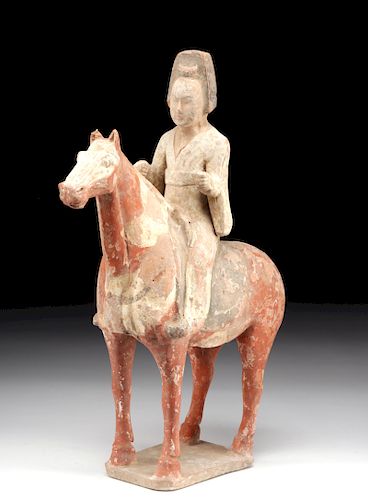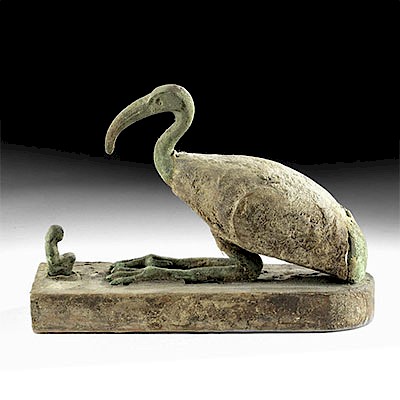Tang Pottery Horse & Female Rider - ex Christie's
Lot 153a
About Seller
Artemis Gallery
686 S Taylor Ave, Ste 106
Louisville, CO 80027
United States
Selling antiquities, ancient and ethnographic art online since 1993, Artemis Gallery specializes in Classical Antiquities (Egyptian, Greek, Roman, Near Eastern), Asian, Pre-Columbian, African / Tribal / Oceanographic art. Our extensive inventory includes pottery, stone, metal, wood, glass and textil...Read more
Estimate:
$3,000 - $6,000
Absentee vs Live bid
Two ways to bid:
- Leave a max absentee bid and the platform will bid on your behalf up to your maximum bid during the live auction.
- Bid live during the auction and your bids will be submitted real-time to the auctioneer.
Bid Increments
| Price | Bid Increment |
|---|---|
| $0 | $25 |
| $300 | $50 |
| $1,000 | $100 |
| $2,000 | $250 |
| $5,000 | $500 |
| $10,000 | $1,000 |
| $20,000 | $2,500 |
| $50,000 | $5,000 |
| $100,000 | $10,000 |
| $200,000 | $20,000 |
About Auction
By Artemis Gallery
Oct 31, 2019
Set Reminder
2019-10-31 10:00:00
2019-10-31 10:00:00
America/New_York
Bidsquare
Bidsquare : Fine Antiquities, Asian, Ethnographic Art
https://www.bidsquare.com/auctions/artemis-gallery/fine-antiquities-asian-ethnographic-art-4581
Our Halloween Day auction features classical antiquities, ancient and ethnographic art from cultures encompassing the globe, plus fine art. Artemis Gallery info@artemisgallery.com
Our Halloween Day auction features classical antiquities, ancient and ethnographic art from cultures encompassing the globe, plus fine art. Artemis Gallery info@artemisgallery.com
- Lot Description
East Asia, China, Tang Dynasty, ca. 618 to 906 CE. A painted terracotta horse and rider, the equestrian figure a female dressed in an elegant headdress and clothing and holding her arms up as if pulling on reins, the pair upon a rectangular base. The horse is standing upon all four hooves implying the rider has brought her noble steed to a halt; however, the horse's head is turned to one side, suggesting animated motion. The pair are glazed with white slip and contrasting red and black details. A special example from the Tang Dynasty displaying exceptional artistry and technique as well as offering layers of iconographical meaning (for more on this, see extended description below). Size: 9.875" L x 3.875" W x 13.375" H (25.1 cm x 9.8 cm x 34 cm)
During the Tang Dynasty, the horse served as both a symbol of imperial stability that engendered bountiful trade and prosperity for the expanding empire and the reward of military exploits to the West. The most cherished horses were raised in the western kingdom of Ferghana and known as "blood-sweating horses". These were delivered as tribute to the reigning emperor. In general, for the ancient Chinese, horses were a sign of wealth.
The female figure demonstrates the hallmarks of the Tang Dynasty style, with her naturalistically rendered, softly contoured round face embellished by meticulously detailed features, her flowing robe with sleeves cascading over her form, as well as her dramatic updo adorned by an elaborate headdress. Being slender, this lady is likely an early Tang female figure; by the mid 8th century CE more voluptuous bodies with full faces and hairstyles described as cloudlike by experts in the field were in favor. Scholars have attributed this shift to Emperor Xuanzong's infatuation with a rather full-figured concubine, the legendary beauty named Yang Guifei. This said, female figures of this body type have been discovered from eras previous to Xuanzong; hence, this embrace of the full figure may simply reflect a change in ideal body types. (For further reading, see Fontein, Jan, Tung Wu, and Museum of Fine Arts, Boston. 1973. Unearthing China's Past, p. 175.)
This piece has been tested using thermoluminescence (TL) analysis and has been found to be ancient and of the period stated. A full report will accompany purchase.
Provenance: private West Chester, Pennsylvania, USA collection, acquired in the early 2000s from Griffin Gallery, Boca Raton, Florida, USA; ex-Christie's, London (sale 9438, July 18, 2002, part of lot 572)
All items legal to buy/sell under U.S. Statute covering cultural patrimony Code 2600, CHAPTER 14, and are guaranteed to be as described or your money back.
A Certificate of Authenticity will accompany all winning bids.
We ship worldwide and handle all shipping in-house for your convenience.
#150240Horse's tail reattached and legs likely repaired, though the repairs are difficult to see. Rider's head probably reattached, though this is difficult to see as well. Minute nicks to horse's ears, rider's headdress, and other high-pointed areas. Normal surface wear with some pigment fading, but much remains - even the very fine details on this lady's face.Condition
- Shipping Info
-
All shipping is handled in-house for your convenience. Your invoice from Artemis Gallery will include shipping calculation instructions. If in doubt, please inquire BEFORE bidding for estimated shipping costs for individual items.
-
- Buyer's Premium



 EUR
EUR CAD
CAD AUD
AUD GBP
GBP MXN
MXN HKD
HKD CNY
CNY MYR
MYR SEK
SEK SGD
SGD CHF
CHF THB
THB














